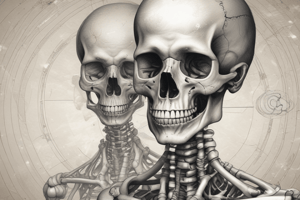Podcast
Questions and Answers
Which of the following is a cause of pathological changes/growth defects to bone?
Which of the following is a cause of pathological changes/growth defects to bone?
- Hereditary errors (correct)
- Bacterial inflammation
- Degeneration and necrosis
- Disorders of metabolism
What is the result of dysostosis?
What is the result of dysostosis?
- Global disorganization of bone and cartilage
- Localized defects in bone or digit formation (correct)
- Extra-skeletal substances affecting epiphyseal mechanism
- Insufficient growth due to errors in epiphyseal mechanisms
What can result from dysplasia?
What can result from dysplasia?
- Global disorganization of bone and/or cartilage (correct)
- Insufficient growth due to errors in epiphyseal mechanisms
- Abnormal growth due to extra-skeletal substances
- Localized defects in bone or digit formation
How many skeletal dysostoses and dysplasias are there?
How many skeletal dysostoses and dysplasias are there?
What are the 4 categories of diseases of skeletal growth?
What are the 4 categories of diseases of skeletal growth?
What can lead to pathological changes in bone?
What can lead to pathological changes in bone?
What is the primary cause of congenital abnormalities?
What is the primary cause of congenital abnormalities?
What type of defects result from dysostosis?
What type of defects result from dysostosis?
What can arise from mutations in genes that control skeletal development or remodeling?
What can arise from mutations in genes that control skeletal development or remodeling?
What is the result of dysplasia?
What is the result of dysplasia?
Which radiographic technique is used to measure bone density?
Which radiographic technique is used to measure bone density?
What is the hallmark of osteoporosis?
What is the hallmark of osteoporosis?
What is the major challenge in pharmacotherapy for osteoporosis?
What is the major challenge in pharmacotherapy for osteoporosis?
What is the characteristic skeletal abnormality associated with untreated primary hyperparathyroidism?
What is the characteristic skeletal abnormality associated with untreated primary hyperparathyroidism?
What is the adult manifestation of impaired remodeling due to vitamin D deficiency?
What is the adult manifestation of impaired remodeling due to vitamin D deficiency?
What does PTH facilitate in the kidneys?
What does PTH facilitate in the kidneys?
What is the characteristic appearance of brown tumors?
What is the characteristic appearance of brown tumors?
What does secondary hyperparathyroidism result in?
What does secondary hyperparathyroidism result in?
What is the most common radiological appearance of osteitis fibrosa cystica?
What is the most common radiological appearance of osteitis fibrosa cystica?
What is the effect of PTH on serum calcium levels?
What is the effect of PTH on serum calcium levels?
Which disorder is characterized by extreme skeletal fragility due to a deficiency in type I collagen?
Which disorder is characterized by extreme skeletal fragility due to a deficiency in type I collagen?
What is the most common skeletal dysplasia resulting from retarded cartilage growth, leading to dwarfish features?
What is the most common skeletal dysplasia resulting from retarded cartilage growth, leading to dwarfish features?
What is the characteristic of osteopetrosis, also known as 'marble bone disease'?
What is the characteristic of osteopetrosis, also known as 'marble bone disease'?
What is the difference between mild and severe types of osteogenesis imperfecta?
What is the difference between mild and severe types of osteogenesis imperfecta?
What is the main cause of postmenopausal osteoporosis?
What is the main cause of postmenopausal osteoporosis?
What is the difference between osteopenia and osteoporosis?
What is the difference between osteopenia and osteoporosis?
What is the characteristic of senile osteoporosis?
What is the characteristic of senile osteoporosis?
What can lead to secondary osteoporosis?
What can lead to secondary osteoporosis?
What influences the pathogenesis of osteoporosis?
What influences the pathogenesis of osteoporosis?
What is the characteristic of osteogenesis imperfecta tarda?
What is the characteristic of osteogenesis imperfecta tarda?
Flashcards are hidden until you start studying
Study Notes
Skeletal Anomalies and Disorders
- Radiological appearance is more helpful than histological patterns in diagnosing congenital anomalies, which range from minor finger phalange absences to complete limb failure.
- The most common anomalies are absent or partial bone and failure in joint segmentation, leading to the formation of an entire big bone.
- Osteogenesis imperfecta is the most common inherited disorder of connective tissue, characterized by extreme skeletal fragility due to a deficiency in type I collagen.
- There are two types of osteogenesis imperfecta: mild (osteogenesis imperfecta tarda) and severe (osteogenesis imperfecta fetalis) with different degrees of skeletal deformities and lifespan.
- Achondroplasia, the most common skeletal dysplasia, is an autosomal dominant disorder resulting from retarded cartilage growth, leading to dwarfish features.
- Osteopetrosis, known as "marble bone disease," is characterized by impaired osteoclast function, resulting in brittle and easily fractured bone, and it can be fatal.
- Osteopenia is decreased bone mass, while osteoporosis is severe osteopenia with a significant risk of fracture.
- Senile osteoporosis is characterized by low-turnover osteoporosis, while postmenopausal osteoporosis is due to decreased estrogen levels and increased osteoclast activity.
- The pathogenesis of osteoporosis is influenced by age-related changes, physical activity, genetic factors, calcium nutritional state, and hormonal influences.
- Postmenopausal osteoporosis affects 40% of postmenopausal women and is mainly caused by decreased estrogen levels and increased osteoclast activity.
- Estrogen deficiency after menopause leads to increased bone resorption and decreased bone formation, especially affecting bones with increased surface area.
- Secondary osteoporosis can occur due to endocrine disorders, GI disorders, and certain drugs, leading to decreased bone mass and increased fracture risk.
Studying That Suits You
Use AI to generate personalized quizzes and flashcards to suit your learning preferences.




